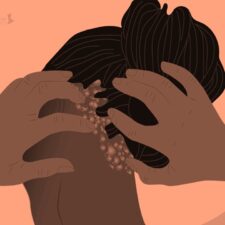
Hives, those annoying, itchy welts that can pop up out of nowhere, might seem like a minor inconvenience. But when you’re suddenly covered in them, it’s natural to wonder what’s causing the breakout. There are some surprising causes of hives you might not expect. But before we get into what is causing them, you may want to understand the difference between hives and a rash–which are very similar.
Hives vs. Rash: What’s the Difference?
Hives and rashes are both skin conditions that can cause redness, swelling, and itching. However, they have distinct characteristics that help differentiate them.
Hives (Urticaria)
Appearance: Raised, itchy welts or bumps that can vary in size and shape.
Cause: Typically an allergic reaction to foods, medications, insect bites, or other triggers.
Other symptoms: May be accompanied by swelling of the lips, tongue, or throat, difficulty breathing, and anaphylaxis (a severe allergic reaction).
Duration: Hives usually appear and disappear within a few hours to days.
Rash
Appearance: Can vary widely, from flat red patches to raised, scaly bumps.
Cause: Can be caused by a variety of factors, including infections, allergies, contact with irritants, or skin conditions (e.g., eczema, psoriasis).
Other symptoms: May be accompanied by pain, dryness, or peeling.
Duration: Rashes can last for hours, days, or even weeks, depending on the underlying cause.
Key Differences
Appearance: Hives are raised, itchy welts, while rashes can vary in appearance.
Cause: Hives are typically allergic in origin, while rashes can have a wider range of causes.
Duration: Hives usually resolve within a few days, while rashes can last longer.
Other symptoms: Hives may be accompanied by anaphylaxis, while rashes may cause pain or dryness.
What Could Be Causing Hives on Black Skin
1. Exercise-Induced Hives
You might think that exercise is only beneficial for your health, but for some, it can lead to a hive breakout. Known as exercise-induced urticaria, this condition causes hives to appear during or after physical activity. The exact cause isn’t clear, but it’s believed to be related to the body’s release of histamines during intense exercise. If you notice hives forming after your workout, it might be worth consulting a doctor. Simple adjustments like modifying the intensity of your exercise routine or taking antihistamines beforehand could help manage the symptoms.
2. Temperature Changes
Believe it or not, sudden changes in temperature can also trigger hives. This is known as cold-induced or heat-induced urticaria. For instance, stepping into a cold shower, swimming in chilly water, or even exposure to cold wind can cause hives in some people. On the other end of the spectrum, hot showers, warm weather, or sweating can also be triggers. To prevent this, try to avoid sudden temperature shifts and consider wearing protective clothing in extreme weather conditions.
3. Pressure or Friction
Another unexpected cause of hives is pressure or friction on the skin, known as dermatographic urticaria or “skin writing.” Simple actions like scratching your skin, wearing tight clothing, or even carrying a heavy bag can lead to hives. The hives typically appear in the form of red, raised lines or welts where the skin has been rubbed or pressed. If you experience this, switching to loose-fitting clothing and avoiding activities that apply prolonged pressure to your skin can help.
4. Certain Medications
While it’s common knowledge that allergies to medications can cause hives, some non-allergic reactions to medications might surprise you. For example, non-steroidal anti-inflammatory drugs (NSAIDs) like ibuprofen, certain antibiotics, and even aspirin can sometimes trigger hives without an allergic reaction. If you suspect your medication is the culprit, consult your healthcare provider. They might recommend an alternative treatment or suggest taking antihistamines to counteract the reaction.
When Should You See a Doctor for Your Rash
You should get a rash checked out if it is accompanied by a fever, appears suddenly and spreads rapidly, blisters, has pus or open sores, is painful, covers a large area of your body, is accompanied by swelling or redness beyond the rash area, or if you experience difficulty breathing or swallowing alongside the rash; these could indicate a serious allergic reaction or infection and require immediate medical attention.
Key signs to seek medical advice for a rash:
Fever: A rash with a fever could signify a bacterial or viral infection.
Blistering: Blisters, especially around the mouth, eyes, or genitals, can be a sign of a more serious condition.
Rapid spread: A rash that quickly spreads across a large area of your body could be an allergic reaction.
Pus or drainage: Yellow or green fluid from the rash indicates infection.
Severe pain: A painful rash may require medical evaluation.
Swelling or redness beyond the rash area: This could indicate a more serious underlying issue.
Difficulty breathing: If your rash is accompanied by breathing problems, seek immediate medical attention.
Managing Unexpected Hives
If you find yourself unexpectedly breaking out in hives, it’s important to keep track of your activities, diet, and environment to identify potential triggers. Keeping a diary of when the hives appear and any associated factors can be incredibly helpful for your healthcare provider in diagnosing and treating the condition.
Hives can be frustrating and uncomfortable, especially when you don’t know what’s causing them. By understanding these four unexpected triggers—exercise, temperature changes, pressure or friction, and certain medications—you can take steps to manage and potentially prevent future breakouts. Always consult with a healthcare professional if you experience frequent or severe hives to rule out underlying conditions and to develop an effective treatment plan.
Understanding the surprising causes of hives can empower you to take control of your health and find relief from this irritating condition.









